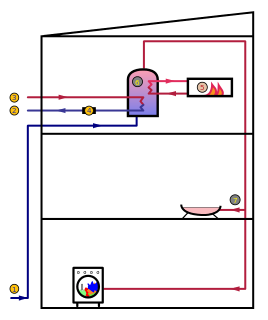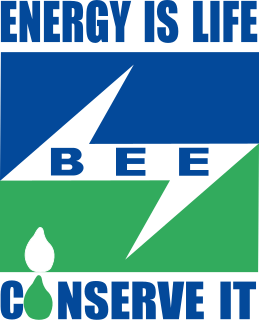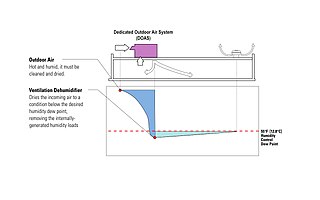
Energy Star is a program run by the U.S. Environmental Protection Agency (EPA) and U.S. Department of Energy (DOE) that promotes energy efficiency. The program provides information on the energy consumption of products and devices using different standardized methods. The Energy Star label is found on more than 75 different certified product categories, homes, commercial buildings, and industrial plants. In the United States, the Energy Star label is also shown on the Energy Guide appliance label of qualifying products.

Water heating is a heat transfer process that uses an energy source to heat water above its initial temperature. Typical domestic uses of hot water include cooking, cleaning, bathing, and space heating. In industry, hot water and water heated to steam have many uses.
The coefficient of performance or COP of a heat pump, refrigerator or air conditioning system is a ratio of useful heating or cooling provided to work (energy) required. Higher COPs equate to higher efficiency, lower energy (power) consumption and thus lower operating costs. The COP usually exceeds 1, especially in heat pumps, because, instead of just converting work to heat, it pumps additional heat from a heat source to where the heat is required. Most air conditioners have COP of 2.3 to 3.5. Less work is required to move heat than for conversion into heat, and because of this, heat pumps, air conditioners and refrigeration systems can have a coefficient of performance greater than one. However, this does not mean that they are more than 100% efficient, in other words, no heat engine can have a thermal efficiency of 100% or greater. For complete systems, COP calculations should include energy consumption of all power consuming auxiliaries. COP is highly dependent on operating conditions, especially absolute temperature and relative temperature between sink and system, and is often graphed or averaged against expected conditions. Performance of Absorption refrigerator chillers is typically much lower, as they are not heat pumps relying on compression, but instead rely on chemical reactions driven by heat.

EU Directive 92/75/EC established an energy consumption labelling scheme. The directive was implemented by several other directives thus most white goods, light bulb packaging and cars must have an EU Energy Label clearly displayed when offered for sale or rent. The energy efficiency of the appliance is rated in terms of a set of energy efficiency classes from A to G on the label, A being the most energy efficient, G the least efficient. The labels also give other useful information to the customer as they choose between various models. The information should also be given in catalogues and included by internet retailers on their websites.
The efficiency of air conditioners is often rated by the seasonal energy efficiency ratio (SEER) which is defined by the Air Conditioning, Heating, and Refrigeration Institute in its 2008 standard AHRI 210/240, Performance Rating of Unitary Air-Conditioning and Air-Source Heat Pump Equipment. A similar standard is the European seasonal energy efficiency ratio (ESEER).

The fuel economy of an automobile relates distance traveled by a vehicle and the amount of fuel consumed. Consumption can be expressed in terms of volume of fuel to travel a distance, or the distance travelled per unit volume of fuel consumed. Since fuel consumption of vehicles is a significant factor in air pollution, and since importation of motor fuel can be a large part of a nation's foreign trade, many countries impose requirements for fuel economy. Different methods are used to approximate the actual performance of the vehicle. The energy in fuel is required to overcome various losses encountered while propelling the vehicle, and in providing power to vehicle systems such as ignition or air conditioning. Various strategies can be employed to reduce losses at each of the conversions between the chemical energy in the fuel and the kinetic energy of the vehicle. Driver behavior can affect fuel economy; maneuvers such as sudden acceleration and heavy braking waste energy.

The Energy Policy and Conservation Act of 1975 (EPCA) is a United States Act of Congress that responded to the 1973 oil crisis by creating a comprehensive approach to federal energy policy. The primary goals of EPCA are to increase energy production and supply, reduce energy demand, provide energy efficiency, and give the executive branch additional powers to respond to disruptions in energy supply. Most notably, EPCA established the Strategic Petroleum Reserve, the Energy Conservation Program for Consumer Products, and Corporate Average Fuel Economy regulations.

The EnergyGuide provides consumers in the United States information about the energy consumption, efficiency, and operating costs of appliances and consumer products.
Heating seasonal performance factor (HSPF) is a term used in the heating and cooling industry. HSPF is specifically used to measure the efficiency of air source heat pumps.
A minimum energy performance standard (MEPS) is a specification, containing a number of performance requirements for an energy-using device, that effectively limits the maximum amount of energy that may be consumed by a product in performing a specified task.

Miles per gallon gasoline equivalent is a measure of the average distance traveled per unit of energy consumed. MPGe is used by the United States Environmental Protection Agency (EPA) to compare energy consumption of alternative fuel vehicles, plug-in electric vehicles and other advanced technology vehicles with the energy consumption of conventional internal combustion vehicles rated in miles per U.S. gallon.

The United States Department of Energy's State Energy Program (SEP) provides grants to states and directs funding to state energy offices from technology programs in Office of Energy Efficiency and Renewable Energy. States use grants to address their energy priorities and program funding to adopt emerging renewable energy and energy efficiency technologies. Started in 2010, the program "is the only program administered by the U.S. Department of Energy (DOE) that provides cost-shared resources directly to the states for allocation by the governor-designated State Energy Office for use in energy efficiency and clean energy innovation, development, and demonstration activities.”

The United States is the second-largest single consumer of energy in the world. The U.S. Department of Energy categorizes national energy use in four broad sectors: transportation, residential, commercial, and industrial.

The Bureau of Energy Efficiency is an agency of the Government of India, under the Ministry of Power created in March 2002 under the provisions of the nation's 2001 Energy Conservation Act. The agency's function is to develop programs which will increase the conservation and efficient use of energy in India. The government has proposed to make it mandatory for certain appliances in India to have ratings by the BEE starting in January 2010. The mission of Bureau of Energy Efficiency is to "institutionalise" energy efficiency services, enable delivery mechanisms in the country and provide leadership to energy efficiency in all sectors of the country. The primary objective would be to reduce energy intensity in the economy.

The National Appliance Energy Conservation Act of 1987 is a United States Act of Congress that regulates energy consumption of specific household appliances. Though minimum Energy Efficiency Standards were first established by the United States Congress in Part B of Title III of the Energy Policy and Conservation Act (EPCA), those standards were then amended by the National Appliance Energy Conservation Act of 1987, the Energy Policy Act of 1992 and the Energy Policy Act of 2005.

The gallon per watt-hour or (G/Wh) is a formula used to test the efficiency of a pool pump or sump pump.

In Australia and New Zealand, an energy rating label or energy rating is a label affixed to various appliances prior to retail sale, which allows consumers to compare the energy efficiency of product and allows consumers to know how much power a particular model will use to run. They allow consumers to compare the energy consumption of similar products, and factor lifetime running cost into their purchasing decision. The energy rating label is a mandatory comparison label under Australian regulations for store sales but not for products sold online. The label comprises an energy consumption figure for the appliance and a star rating. The energy consumption figure is an estimate of how much energy the appliance will use over a year, based on assumptions about “average usage”.
The Energy Conservation Program for Consumer Products Other Than Automobiles is a regulatory program that enforces minimum energy conservation standards for appliances and equipment in the United States. The program was established under Part B of Title III of the Energy Policy and Conservation Act of 1975 and gives the Department of Energy (DOE) the authority to develop and implement test procedures and minimum standards for more than 50 products covering residential, commercial and industrial, lighting, and plumbing applications. The Department of Energy is required to set standards that are "technologically feasible and economically justified."

Moisture Removal Efficiency (MRE) is a measure of the energy efficiency of any dehumidification process. Moisture removal efficiency is the water vapor removed from air at a defined inlet air temperature and humidity, divided by the total energy consumed by the dehumidification equipment during the same time period, including all fan and pump energy needed to move air and fluids through the system.

Residential water use includes all indoor and outdoor uses of drinking quality water at single-family and multifamily dwellings. These uses include a number of defined purposes such as flushing toilets, washing clothes and dishes, showering and bathing, drinking, food preparation, watering lawns and gardens, and maintaining swimming pools. Some of these end uses are detectable while others are more difficult to gauge.


















